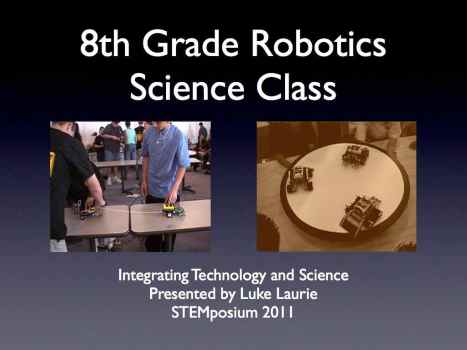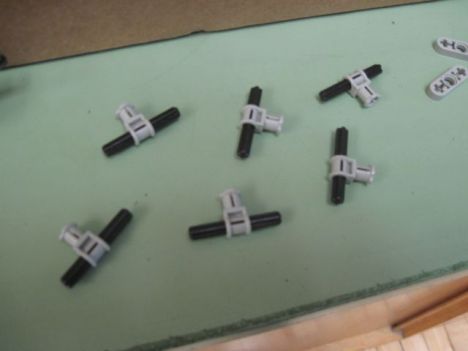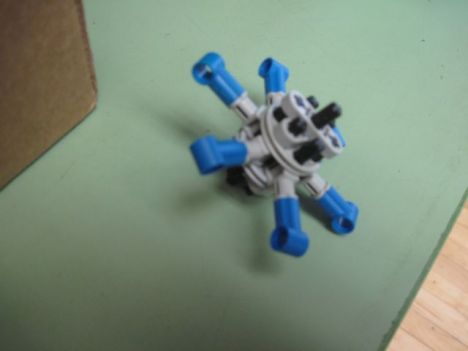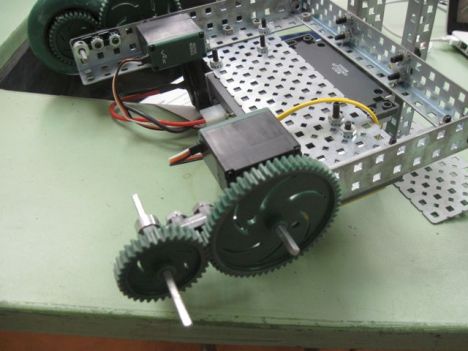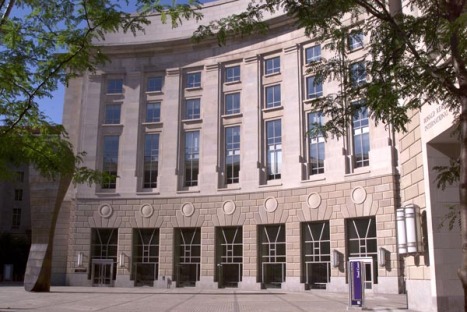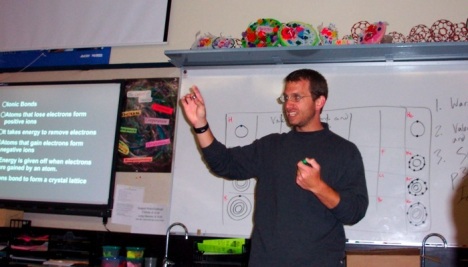
In 2007, I testified at a field hearing on the issues facing science education in the NCLB influenced standards-based era. In light of a forum taking place this weekend at Cal Poly, I am reposting this testimony.
Testimony of Luke Laurie
Science Teacher, El Camino Junior High, Santa Maria, CA
Director: RoboChallenge
mrlaurie@mac.com
given to the
SELECT COMMITTEE ON
SCHOOLS AND COMMUNITY
Senator Tom Torlakson, Chair
October 30, 2007
Cal Poly, Keck Laboratory
San Luis Obispo
Mr. Chairman, members of the committee, thank you for allowing me to speak today on the critical issues of learning environments and science education equipment needs for California’s classrooms.
My name is Luke Laurie. I am a science teacher at El Camino Junior High in Santa Maria, California. I have ten years of experience teaching and running after school programs in robotics and engineering. I am a recipient of the Amgen Award for Science Teaching Excellence, and a graduate of Cal Poly.
Last year, as a recipient of the Albert Einstein Distinguished Educator Fellowship, I worked as a legislative assistant in the United States House of Representatives for Congressman Mike Honda, of Silicon Valley, a Member of the Appropriations and Science Committees, and a former science teacher himself. In the House, I worked on education, environmental policy, and appropriations. I worked with Congressman Honda on the Global Warming Education Act, and to end the narrowing of the curriculum, language for the reauthorization of No Child Left Behind to require all schools to provide a comprehensive curriculum to all students.
The school where I teach is not unlike many in California, serving an almost exclusively, low-income Hispanic population, more than half of which are English Language Learners. The opportunities for our students to encounter science and technology professionals in their communities are few, as are the opportunities for them to engage in meaningful science and technical experiences. That said, if we, as educators, do not provide meaningful scientific and technical experiences for students, with hands-on, minds-on learning, they won’t get them.
My time in Washington D.C. last year exposed me to the incredible bipartisan push at the Federal level to enhance science research and STEM education. Members of Congress, scholars, and business leaders agree that STEM education in the U.S. is in dire need of improvement.
Unfortunately, my time in D.C. also exposed me to the great disconnect between the federal infrastructure that provides guidance for public schools, and the framework that has been tasked with improving science education. Funds for improving K-12 science are appropriated to dozens of programs in NASA, NOAA, NSF, The Department of Energy, EPA, and the Department of Education. Rather than going directly to the schools with the greatest needs, these funds largely go to universities for outreach efforts. The results of outreach are often very good, creating amazing programs and providing unique opportunities for children, but they are also frequently short-lived, and directly affect only a small fraction of schools. The result creates a long and windy road for federal funds to science classrooms, and the trickle down effect often leaves some schools dry.
With frequent reports on the lack of science and technical literacy of American students, the concerns over global competitiveness, and the specter of global warming, one would think that science at all levels would see increased attention, increased funding, and especially, increased time devoted to science. Working down in the trenches, I can tell you from experience, that such is not the case.
Standards-based instruction and high stakes testing, the cornerstones of California education policy and the federal No Child Left Behind Act, have indirectly harmed science education, as well as education in the myriad of subjects beyond Language Arts and Mathematics.
The emphasis on Mathematics and Language Arts in testing and evaluation have created circumstances where well-meaning local administrators have issued directives or modified curricula that effectively discourage science instruction, and reduce or eliminate the time that would otherwise have been devoted to science. They are gaming the system; because they can, and because they believe they need to. In effect, the climate is such that there is no penalty for schools where science isn’t taught at all. The same could be said for other subjects, such as PE, health and nutrition, fine and performing arts, industrial arts, and technical education. The very subjects that may determine our future economic stability are seen as impediments to schools chasing the ever elusive AYP or API, in spite of their cultural and economic value, and in spite of their role in retaining students and preventing drop-outs. The current climate encourages short term gains, even when the trade-off is long term losses.
In the district in which I teach, a block schedule was implemented which provides junior high students with Math and Language Arts courses every day, but PE, Science, and Social Studies, meet every other day or for only half the year. Some English Language Learners have no science at all, or are given one quarter of science, while they are placed in a reading intervention class that is in addition to their language arts class- that’s 160 minutes of language arts in a day. There are only 3 full time science teachers in my school, serving a population of over 600 students.
In some schools, the precious time they have to teach science is taken up with weekly math review, or extra reading time. The time is taken out of science as it is considered a non-essential course.
Some of the greatest impact have been on elementary science instruction. Many elementary teachers I have spoken to who are passionate about science education have been forced to reduce their time spent on science. Some express great frustration, because of drill and kill tactics and extended time on Math and Language arts, they are unable to implement the science units they used to teach, which integrated mathematics, reading, writing, and vocabulary development, and used these skills in context.
Don’t get me wrong, literacy, acquiring English, and mathematics are vital skills, however, the overemphasis on these subjects has been harmful, because science is less frequently used as the context for language development, and context for application of mathematics. The common defense for this overemphasis is that while deferring these subjects, we are providing students with a stronger framework for future coursework. Such could be tested, however, there is a tendency, especially for students in English Language Learner programs to defer science year, after year, after year. It is a disservice to these students to remove them from the courses in which the language is universal, the minds will be engaged, and students will be able to experience success. At the junior high level we are not seeing students more prepared for science instruction because of their work in mathematics and language arts. In fact, we’re seeing fewer students able to apply mathematics skills to real situations, such as the ability to measure or estimate, and we’re seeing less in the way of prior science knowledge. They are likely to have strongly-embedded misconceptions about ordinary phenomena, and they are less prepared to learn science.
Fortunately, in spite of these policies and trends, the programs that I personally work on have been strongly supported by my site administration, and we’re fighting to keep science alive. We have been able to channel grant funds and awards into strengthening my Robotics Science Course for 8th grade students, and we’ve been able to maintain strong participation in MESA (Mathematics, Engineering, and Science Achievement).
But all of the grant funds we have acquired have provided little other than equity with wealthier California schools. We need 5000 dollars in grants each year just to keep pace. The lack of equity in funding requires teachers in schools such as mine to beg and borrow- just to get what may be provided in the next zip code.
With what we have, we have converted some regular classrooms into what you might call labs. We even have a single room designated as “science lab” on our school map. But this old classroom doesn’t have hot water, is poorly lit, has no access to gas for Bunsen burners, and if we plug in too many hot plates, it will blow out the low-amperage circuits. We make it work. Is it a science lab? I’m not sure.
This brings me to a concept I call “Faith-Based” education. I don’t mean faith in the religious sense. What I mean is that, commonly, education policy neglects to provide much needed resources- or fails to institutionalize or require instruction that all students must definitely have. Instead, we take it on faith, that somewhere out there, some courageous teacher will pick up the ball and fill in the holes that were made by omissions of policy or shortages of funding. We see this in the teachers that go around fixing the school’s outdated computers, and the lone elementary teacher who will still take kids on science field trip, or teach their unit on whales, or growing plants from seeds- even when science has been alloted no time in the day. Or the elementary teacher who still goes out to teach PE- every day. We see this in the teachers who are working in my program, RoboChallenge, having students learn language and mathematics skills while designing and programming their own robots.
We should not have to rely on faith that good instruction and a comprehensive curriculum including robust science is being taught in public schools in California. With one of the largest economies in the world, a world-class university system, and the wealth of corporate resources, California should have a world class K-12 education system, and world class learning environments for all students. Increased investment in K-12 science is a drop in the bucket compared to the benefits we will reap from a strong workforce, our ability to curtail and adapt to climate change, and the cultural and technological benefits that will arise from tomorrow’s innovators.
Filed under: Education, Science | Tagged: competitiveness, curriculum, Education, Engineering, equity, innovation, mathematics, nclb, Robotics, Science, standards-based instruction, STEM, STEM education, technology | 1 Comment »



